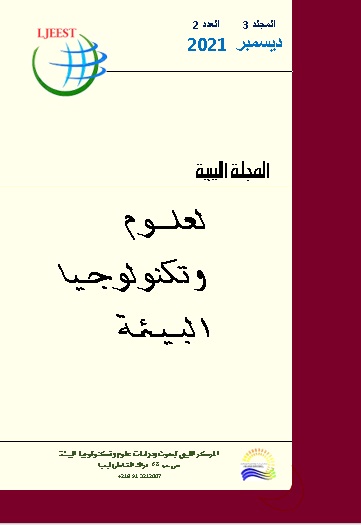دراسة بيئية ومعرفية عن نبات المرسين (الفصيلة الأسية) في الجبل الأخضر- ليبيا
DOI:
https://doi.org/10.63359/6mrbxg45الكلمات المفتاحية:
Ethnobotanical، Allelopathic، Myrtus communis، Recipient speciesالملخص
نبات الميرسين (Myrtus communis) شجيرة دائمة الخضرة ومنتشرة في البحر الأبيض المتوسط. تحتوي ثمارها وأوراقها على خصائص مضادة للأكسدة ومضادة للبكتيريا ومضادة للفطريات، و تستخدم اساساً لمحتواها من الزيوت العطرية، أما الأكثر استخداماً محلياً هو كعصير المصنوع من الثمار. مما أدى إلى الاستغلال المفرط لنبات الميرسين و تقليل التغطية الجغرافية النباتية و حجم الأفراد للنوع. أجريت هذه الدراسة للتحري عن أصل النبات و معرفة الأسباب الرئيسية لاستخداماته الشعبية ethnobotanical وطريقة استخدامه، و توزيعه الجغرافي في منطقة الجبل الأخضر بليبيا. كما تم إجراء تجربة التضاد الكيميائي allelopathic كعملية بيئية في تنظيم تجمع النباتات في النظم البيئية. فكانت استخدامات النبات في الطب الشعبي كعامل منكه وللعلاج المعدي والتقليل من الحركة المعوية هو 90٪ و 10.9٪ على التوالي. مستخلص أوراق الميرسين يُساعد على خفض مستويات السكر في الدم لدى المُصابين بفرط مستويات السكر في الدم كما تم تسجيل استخدام النبات لمرض السكر (60٪)، تنقية الدم والإمساك (6.6٪). وأظهرت نتائج اختبار allelopathic على الإنبات والمقاييس الحيوية للنمو أن نسبة الإنبات (GP) لنبات الشعيرHordeum vulgare و لنبات القمح Triticum aestivum(الأنواع المتلقية) كانت معنوية (P≤ 0.05). انخفت نسبة الانبات مع زيادة تركيز خلاصة أوراق نبات الميرسين كما انخفض طول النبات وطول الجذور مع زيادة تركيز المستخلص الورقي لنبات الميرسين، بينما كان العكس صحيحاً بالنسبة للوزن الجاف للشتلات التي زادت مع زيادة تركيز المستخلص.
المراجع
Ahwaidi, G. M. A. (2017). Factors Affecting Recent Vegetation Change in North-East Libya. PhD thesis. School of Environment and Life Sciences. The University of Salford. The UK.
Ali K, Khan N, Rahman IU. (2013) Understanding the Ethno-cultural domain of the Swat Valley, Northern Pakistan. International Journal of Advanced Research, 1(8), 223-239
Almesmari, N. M. G. (2019). Natural Vegetation Cover Changes in North-East Libya. PhD thesis. School of Water, Energy, Environment and Agrifood. Cranfield University. UK.
Al-Zani, Al-Senussi (1986). Types of Forests and Grasslands Endangered in Libya, First Conference for the Protection of Libyan Natural Resources, Omar Al-Mukhtar University - Al-Bayda.
Babaee, N.; Mansourian, A.; Momen-Heravi, F. Moghadamnia, A. and Momen-Beitollahi, J.(2010).The efficacy of a paste containing Myrtus communis (Myrtle) in the management of recurrent aphthous stomatitis: A randomized controlled trial, Clin Oral Investig,14, 65-70.
Bahadırlı, Nadire Pelin; Kahramanoğlu,İbrahim and Wan,Chunpeng (2020). Exposure to Volatile Essential Oils of Myrtle (Myrtus communis L.) Leaves for Improving the Postharvest Storability of Fresh Loquat Fruits. Journal of Food Quality, vol. 2020, Article ID 8857669, 10 pages, https://doi.org/10.1155/2020/8857669
Bertholdsson, N.O. (2012). Allelopathy-A tool to improve the weed competitive ability of wheat with herbicide-resistant Alopecurus myosuroides Huds. Agronomy, 2, 284-294.
El-Barasi, Y. M. M., & Saaed, M. W. B. (2013). Threats to Plant Diversity in the North Eastern Part of Libya (Al Jabal Al Akhdar and Marmarica Plateau). Journal of Environmental Science and Engineering A, 2, 41–58.
El-Darier, S. M. and Youssef, R. S. (2017). Does salinity enhance allelopathic effects of Tribulus terrestris L. in Citrullus vulgaris schrad. agroecosystems at Nobaria, Egypt. Direct Research Journal of Agriculture and Food Science, 5 (1), 1-8.
El-Darier, S. M.; El-Kenany, E. T.; Abdellatif, A. A. and Abdel Hady, E. F. (2018). Allelopathic prospective of Retama raetam L. against the noxious weed Phalaris minor Retz. Growing in Triticum aestivum L. fields. Article in Rendiconti Lincei. Scienze Fisiche Naturali, 29,12-16.
Ertug F. (2004). Wild Edible Plants of the Bodrum Area (Mugla, Turkey). Turkish Journal of Botany, 28, 161-174.
Giampieri, F.; Cianciosi, D. and Forbes-Hernández, T. (2020). Myrtle (Myrtus communis L.) berries, seeds, leaves, and essential oils: New undiscovered sources of natural compounds with promising health benefits. Food Frontiers, 1,276–295.
Hosseinzadeh L, Behravan J, Mosaffa F, Bahrami G, Bahrami A, Karimi G. (2011). Curcumin potentiates doxorubicin-induced apoptosis in H9c2 cardiac muscle cells through generation of reactive oxygen species. Food and Chemical Toxicology, 49(5), 1102-1109.
Hussain, S.; Siddiqui, S.U.; Khalid, S.; Jamal, A.; Qayyum, A. and Ahmad, Z. (2007). Allelopathic potential of Senna (Cassia angustifolia Vahl) On germination and seedling characters of some major cereal crops and their associated grassy weeds. Pakistan Journal of Botany, 39, 1145-1153.
Junaedi, A.; Jung, W.S.; Chung, I.M. and Kim, K.H. (2010). Differentially expressed genes of potentially allelopathic rice in response against barnyardgrass. Journal of Crop Science and Biotechnology, 10 (4), 231- 236.
Keith, H.G. (1965). Apreliminary check list Libyan flora, Libya minis. Agric. Tripoli.
Khan N, Ali K, Shawkat SS, Muhammad Z. (2016). Distribution of Pinus roxburghii Sargent associations with environmental correlates in the Swat Hindukush range of Pakistan under current and future climate scenarios. Turkish Journal of Botany, 40, 1603-1607.
Kishwar Ali , Farman Ullah, Nasrullah Khan, Inayat Ur Rahman, Shariat Ullah, Waqar Khan, Murad Ali, Nisar Uddin, Mohammad Nisar.(2017). Ethnobotanical and ecological study of Myrtus communis (L.) in Bajaur agency (FATA) Khyber-Pakhtunkhwa, Pakistan. Journal of Biodiversity and Environmental Sciences (JBES) ISSN: 2220-6663 (Print) 2222-3045 (Online), 11 (1), 152-164.
Kishwar Ali, Farman Ullah, Nasrullah Khan, Inayat Ur Rahman, Shariat, Waqar Khan, Murad Ali and Nisar Uddin (2017). Ethnobotanical and ecological study of Myrtus communis in Bajaur agency (FATA) Khyber-Pakhtunkhwa, Pakistan. Journal of Biodiversity and Environmental Sciences (JBES), 11(1), 152-164.
Labbafi, M.; Hejazi, A.; Maighany, F.; Khalaj, H. and Mehrafarin, A. (2010). Evaluation of allelopathic potential of Iranian wheat (Triticum aestivum L.) cultivars against weeds. Agriculture and Biology Journal of North America, 1(3), 355-361.
Melito, S., Chessa, I., Erre, P, Podani, J. and Mulas, M. 2013. The genetic diversity of Sardinian myrtle (Myrtus communis L.) populations. Electronic Journal of Biotechnology,16(6), 1-14.
Migliore, J.; Baumel, A.; Juin, M.; Médail, F. (2012). From Mediterranean shores to central Saharan mountains: Key phylogeographical insights from the genus Myrtus. J. Biogeogr. 39, 942–956.
Montoro P, TuberosoCIG,Piacente S, Perrone A, De FV, Cabras P, Pizza C. (2006). Stability and antioxidant activity of polyphenols in extracts of Myrtus communis L. berries used for the preparation of myrtle liqueur. Journal of Pharmacognocy and Biomedical Analysis, 41, 1614–1619.
OMU. (2005). Studying and evaluating the natural vegetation cover in Al Jabal Al Akhdar area. Omar Al-Mukhtar University. Al Bieda, Libya. (In Arabic)
Qaiser, M., & Siddiqi, M. A. (1986). 122: Myrtaceae. In S. M. H. Jafri & A. El-Gadi (Eds.). Flora of Libya. Tripoli: Al-Faateh University.
Reigosa, M.J.; Pedrol, N. and Gonza, L. (2006). Allelopathy-a physiological process with ecological implications. Springer, Berlin, 39,8-15.
Saeed, Abdel Khaleq. (2004). The response of some coarse wheat varieties to the vegetative excretions of the barley crop. Hordeum vulgare. Iraqi Journal of Agricultural Sciences, 5, 94-101.
Santos, C.P. (2000). Succession of Breeding Bird Communities After the Abandonment of Agricultural Fields in South-East Portugal. Ardeola, 47(2), 171-181.
Serce, S.; Ercisli, S.; Sengul, M.; Gunduz, K. and Orhan, E. (2010). Antioxidant activities and fatty acid composition of wild grown myrtle (Myrtus communis L.) fruits. Pharmacognosy Magazine, 6, 9-12.
Serio A, Chaves-López C, Martuscelli M, Mazzarrino G, Di Mattia C, Paparella A. (2014). Application of Central Composite Design to evaluate the antilisterial activity of hydro-alcohol berry extract of Myrtus communis L. LWT-Food Science and Technology, 58(1), 116-123.
Soejarto, D.D.; Gyllenhaal, C.; Riley, M.C. and Zhang, H. (2011). Ethnobotany of natural products. In: Phytochemistry and Pharmacognosy section, Chemical Sciences, Engineering and Technology Resources, Encyclopedia of Life Support Systems (EOLSS), Developed under the Auspices of the UNESCO, EOLSS Publishers, Oxford, UK.
Sumbul S, Ahmad MA, Asif M, Akhtar. 2011. Myrtus communis L. A review. Indian Journal Natural Production Resources, 2(4), 395-402.
Tehmina, A. and Bajwa, R. (2005). Allelopathic potential of sunflower (Helianthus annuus L.) as natural herbicide. 6th National Weed Science Conference. NWFP Agricultural University, Peshawar, pp.17.
Thornhill, A.H.; Ho, S.Y.W.; Külheim, C.; Crisp, M.D. (2015). Interpreting the modern distribution of Myrtaceae using a dated molecular phylogeny. Molecular Phylogenetics Evolution, 93, 29–43.
Traveset A, Riera N, Mas RE. (2001). Ecology of Fruit-colour Polymorphism in Myrtus communis L. and Differential Effects of Birds and Mammals on Seed Germination and Seedling Growth. Journal of Ecology, 89, 749-760.
Tuzlacı E. (2006). Şifa Niyetine the Herbal Medicinal Plants of Turkey [in Turkish], İstanbul Alfa Yayınları, No. 1702.
Vasconcelos, T.N.C.; Proença, C.E.B.; Ahmad, B.; Aguilar, D.S.; Aguilar, R.; Amorim, B.S.; Campbell, K.; Costa, I.R.; de Carvalho, P.S.; Faria, J.E.Q.; (2017). Myrteae phylogeny, calibration, biogeography and diversification patterns: Increased understanding in the most species rich tribe of Myrtaceae. Molecular Phylogenetics Evolution, 109, 113–137.
Zatout, M. M. M., & Soliman, A. M. S. (2014). Impact of Overgrazing and Burning on Plant Diversity in the Ras Al-Hilal Region in the North East of Libya. International Journal of Advances in Agricultural & Environmental Engineering, 1(1), 135–138. https://doi.org/10.15242/IJAAEE.C514051.
منشور
إصدار
القسم
الرخصة
الحقوق الفكرية (c) 2025 المجلة الليبية لعلوم وتكنولوجيا البيئة (LJEEST)

هذا العمل مرخص بموجب Creative Commons Attribution-NonCommercial 4.0 International License.














